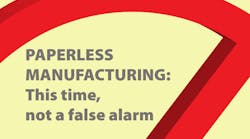Paperless manufacturing: This time, not a false alarm
Manufacturers of all sizes are adopting manufacturing information technologies, which eliminate a lot of paperwork. The technologies have been around for decades, though, so why are manufacturers seeing value in them now?
Product lifecycle management (PLM) is a manufacturing information technology that is a case in point. Siemens, Austin, one of the biggest names in the PLM industry, has 7 million licensed seats and more than 71,000 customers worldwide. Arena Solutions, Foster City, Calif., also a provider of PLM, boosted its customer base by 77% and tripled its average deal size in just one year. Those numbers are hard to ignore.
Steve Chalgren, vice president of product management and strategy at Arena, reports that the company’s growth spurt came partly because it took a leap from small-sized manufacturers to midmarket and large enterprises. “Companies that want to be flexible enough to move operations to any factory location adopt PLM. In addition, product cycles in the industrial sector are starting to mimic those of high tech — and high tech has always had strong PLM adoption,” he says.
Driving the shift
Connecting multiple factories is becoming more important in the global economy. Also, the concept of opening up mini-factories is starting to take hold because efficiency can be tracked more closely with information technologies. Chemical plants are already turning modular. A recent report from Frost & Sullivan states that smaller, more-modular plants are replacing large-scale chemical production plants. The expected result of these mini-factories is a 30% improvement in efficiency.
Efficiency, government regulations, and customer demand have always been major drivers in the ongoing reach for continuous improvement. But improvements are getting more difficult to come by with goals such as zero waste, stricter fuel economy, and, as one manufacturer shared at the PackExpo packaging technology show, “enabling you to jump when Walmart tells you to.” He explained that connecting plant-floor data throughout the enterprise is one of the only ways to survive when a buyer like Walmart decides frozen-fish packaging must change from a box to a stand-up pouch in less than one year.
Yet manufacturers have a reputation for keeping information technologies out of the lineup of strategies used to address these issues. In fact, over 90% of manufacturers still use paper forms and Excel spreadsheets to create reports. So why are manufacturers now open to information technologies like PLM? Are we at a tipping point where manufacturers need information technologies just to survive?
One obvious reason for recent widespread adoption is accessibility and affordability through the cloud. “Legacy PLM is stuck in the large enterprises,” says Chalgren. “The unnecessary complexity and ‘science-project’ toolkit methodology is being destroyed by PLM software companies that offer agility. More CFOs and other execs are adopting the notion of renting SaaS (software as a service) software for immediate ROI (return on investment) and opportunity cost benefits.”
The role of MES
Julie Fraser, principal of the consulting firm Iyno Advisors, Cummaquid, Mass., says while the PLM industry has jumped from desktop to cloud, the uptick in business is mainly because the software has taken on new functions. “PLM has been around for 20-some years and is primarily about designing products effectively. But in recent years, it has also helped design the processes to make those products,” she explains.
“What we’re seeing is a convergence of manufacturing execution systems (MES) and PLM. MES focuses on how you execute in production. So in the case of high tech, where changes are frequent, these two systems need to work together well. Siemens and Dassault Systèmes, Waltham, Mass., have taken the lead on this type of convergence by acquiring MES providers,” Fraser says.
“However, manufacturers themselves, as well as other software providers, are already beginning to make information flow between PLM and MES for real-time changes and updates of product information throughout the life cycle. This integration is finally beginning to fulfill the promise of the end-to-end product lifecycle management vision,” she adds.
For a tutorial on the interaction between product design and plant-floor execution, Fraser recommends the PLM guidebook developed by the manufacturing IT industry association MESA International.

